IDF 2009 - World's First Larrabee Demo, More Clarkdale, Gulftown
by Anand Lal Shimpi on September 22, 2009 12:00 AM EST- Posted in
- Trade Shows
Sean Maloney is getting his speaking practice in and he was back during the afternoon for the second set of keynotes at IDF. This one is a bit more interesting.

Sean started by tackling Pat Gelsinger's old playground: Servers. Nehalem-EX (8-core Nehalem) was the primary topic of discussion, but he also demonstrated the new 32nm Westmere-EP processors due out next year.
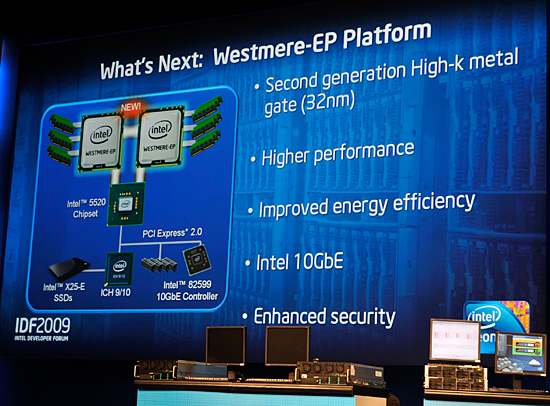
Westmere-EP is the dual-socket workstation/server version of Westmere (aka 32nm Xeon). The feature-set is nearly identical to Westmere on the desktop, so you get full AES acceleration for improved encrypt/decrypt performance. This is particularly useful for enterprise applications that do a lot of encryption/decryption.
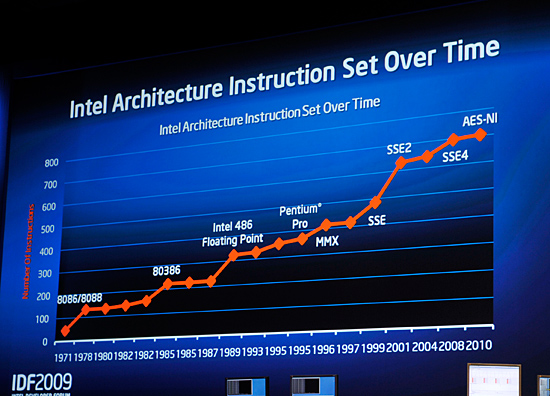
The AES-NI instructions get added to x86 with Westmere. The x86 ISA will be over 700 instructions at that point.
The other major change to the Xeon platform is networking support. The Westmere-EP platforms will ship with Intel's 82599 10GbE controller.
Power consumption should be lower on Westmere and you can expect slightly higher clock speeds as well. If Apple sticks to its tradition, you can expect Westmere-EP to be in the next-generation Mac Pro.
What if you built a Core i7 using 1000nm transistors?
Intel has been on an integration rampage lately. Bloomfield integrated the memory controller and Lynnfield brought the PCIe controller on-die. Sean held up an example of what would happen if Intel had stopped reducing transistor size back in the 386 days.
Here's an image of what the Core i7 die would look like built using ~1000nm transistors instead of 45nm:

That's what a single Core i7 would look like on the 386's manufacturing technology
Assuming it could actually be built, the power consumption would be over 1000W with clock speeds at less than 100MHz.
Next he held up an Atom processor built on the same process:
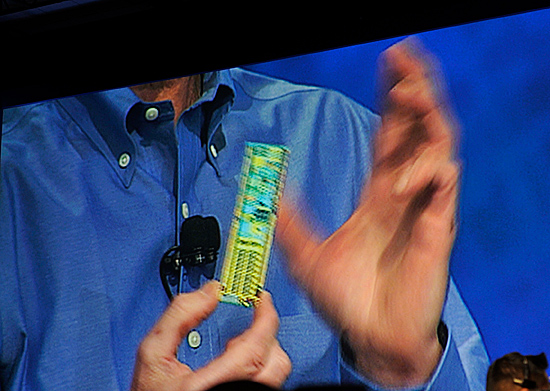
And that's what Sean Maloney shaking an Atom built on the 386's manufacturing process would look like
Power consumption is a bit more reasonable at 65W, but that's just for the chip. You could drive a few modern day laptops off of the same power.
Useful comparisons? Not really, interesting? Sure. Next.
Larrabee Demo
Larrabee is of course at IDF, but its presence is very muted. The chip is scheduled for a release in the middle of next year as a discrete GPU.
Bill Mark, a Senior Research Scientist at Intel, ran a raytracing demo using content from Enemy Territory Quake Wars on a Gulftown system (32nm 6-core) with Larrabee.
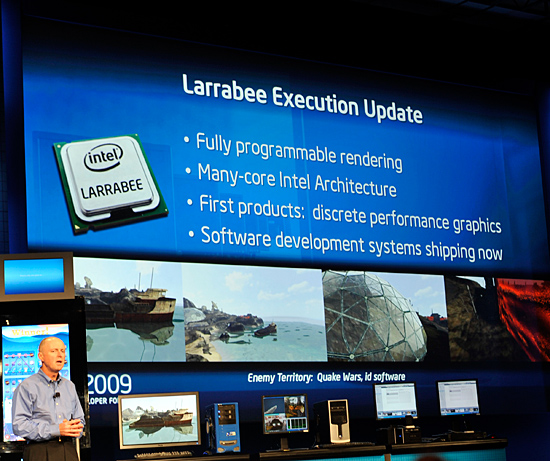
The demo was nothing more than proof of functionality, but Sean Maloney did officially confirm that Larrabee's architecture would eventually be integrated into a desktop CPU at some point in the future.
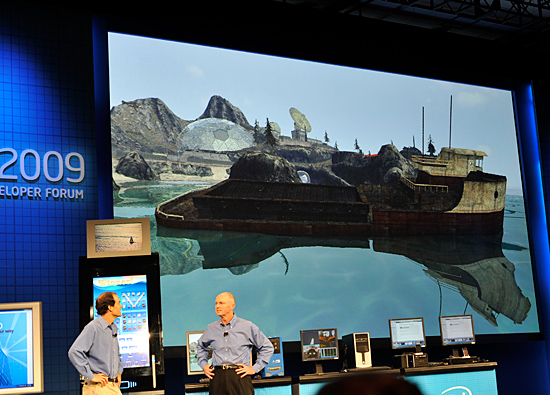
Larrabee rendered that image above using raytracing, it's not running anywhere near full performance
Clarkdale: Dual Core Nehalem
Clarkdale is the desktop dual-core Nehalem due out by the end of this year with widespread availability in Q1 2010.
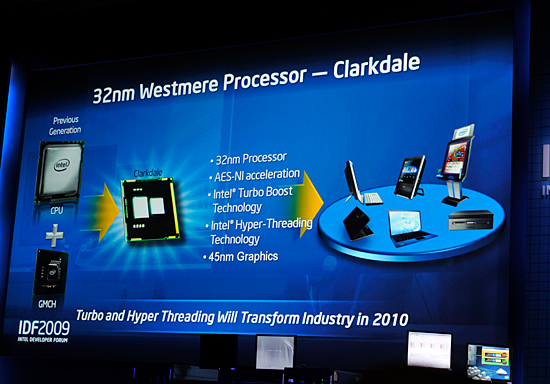
Clarkdale will be the ideal upgrade for existing dual-core users as it adds Hyper Threading and aggressive turbo modes. There's also on-package 45nm Intel graphics, which I've heard referred to as finally "good enough" graphics from Intel.
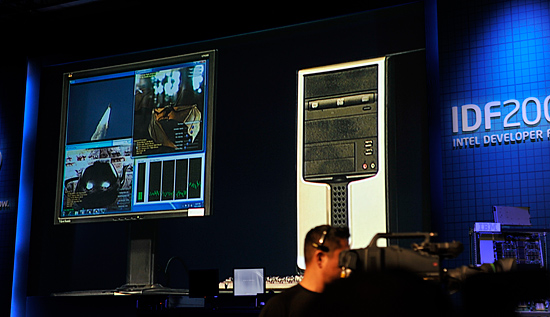
Two cores but four threads, that's Clarkdale
Jasper Forest
Take Nehalem with three DDR3 memory channels, add PCIe 2.0 and RAID acceleration and you've got Jasper Forest. Due out in Q1 2010 this is a very specific implementation of Nehalem for the embedded and storage servers.
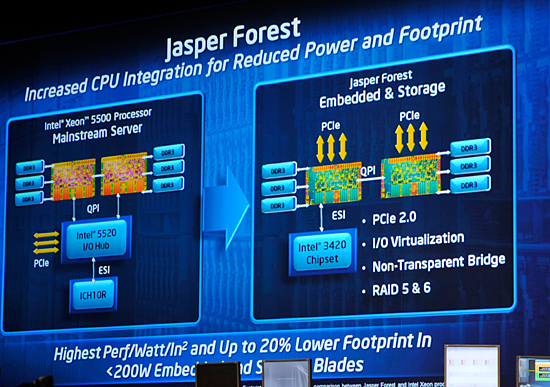
Nehalem was architected to be very modular, Jasper Forest is just another example of that. Long term you can expect Nehalem cores (or a similar derivative) to work alongside Larrabee cores, which is what many believe Haswell will end up looking like.
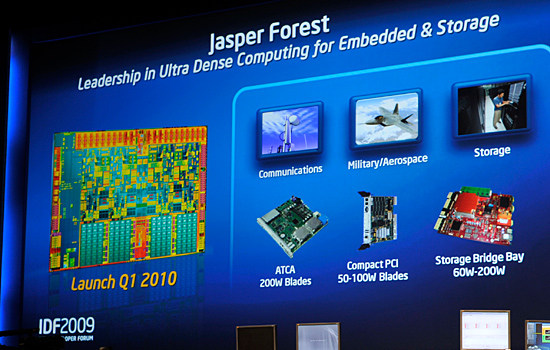
Gulftown: Six Cores for X58
I've mentioned Gulftown a couple of times already, but Intel re-affirmed support for the chip that's due out next year.

Built on the 32nm Westmere architecture, Gulftown brings all of the Westmere goodness in addition to having 6-cores on a single die.
Compatibility is going to be the big story with Gulftown: it will work in all existing X58 motherboards with nothing more than a BIOS update.










47 Comments
View All Comments
TA152H - Wednesday, September 23, 2009 - link
I don't have an i7 920. I wish I did.Most people that talk like you are viewing the world through their own limitations, of which you probably have many. I don't have to rationalize anything I do, and don't have a bias one way or another. I just like the truth, and what's real to be said.
So, don't be patronizing. You're too stupid, and you're wrong. I am interested in technology, for the sake of technology, and it irritates me when sites like this don't really tell it like it really is, and instead impart a bias on it. The worst part is, jackasses like you eat it up without question.
I disagree with you on your assessment of AMD. Really, you don't like to think much beyond the superficial, and that's your main problem. AMD was in a much better situation with the K6 line, since it used much less power, was much smaller, and could be sold much cheaper. It was in some ways superior to the Katmai, because of this, and also, the K6-III was actually faster, clock normalized, than the Katmai on 16-bit integer code.
The present AMD processors flat out suck. They are the same size, consume more power, and perform miserably. I guess one plus though is, the K6 platform, Super 7, was horrible, with the MVP3 being the most stable chipset. The ALI was dreadful, the MVP3 still bad. Now, they have a nice platform, but the processors are dreadful. From that perspective, I think the Athlon was a very, very important and excellent decision by AMD.
I'm inclined to agree with your sentiment that AMD better get their design competitive again, or the other stuff like platform and outmaneuvering Intel will not hold out forever. But, given what they have, and can realistically do in the near term, I think it's a very, very smart move.
Lynnfield confuses the market. I think they would have been better off just increasing clock speeds the Core 2 line. They are cheaper to make, have an IGP, and are mature platform. Lynnfield would have made a lot of sense on 32nm.
You're right, two weeks isn't a lot, but when you already suspected a product wouldn't sell, and then it doesn't, it's a pretty strong confirmation. It's like running an experiment you already know the results of.
I don't think the technology is all bad, I think it's positioned wrong. Apparently, so does the market. Intel may have thought they could fool people by lobotomizing the platform, but, really, no one is fooled. When they get rid of the Core 2, and this becomes their low-end platform, it's going to be a killer in that segment. Again, I think it's just positioned wrong, for now, and will settle in when they put the video on it, and the costs come down.
Lifted - Thursday, September 24, 2009 - link
I stopped reading this drivel after the first 2 paragraphs. You sound like a teenager trying playing on his xbox."limitations, of which you probably have many."
"You're too stupid"
"jackasses like you"
Grow the f@ck up.
Griswold - Wednesday, September 23, 2009 - link
Stop trying to "think". It doesnt seem to work well.chrnochime - Tuesday, September 22, 2009 - link
What IS that URL of your website anyway? Curious to see how much better your site actually is compared to Anand's.And if you can't show some benchmarks and white paper(NOT what you wrote) to back up what you're saying, like the old saying goes...
hyvonen - Wednesday, September 23, 2009 - link
You know, for a long time I thought TA152H was just an Intel-hating troll, but I think I have just changed my mind. Pretty much everything he says makes sense, even down to the $99 Athlon.Although I have to disagree that Lynnfield was completely pointless; it was a stop-gap measure, trying to slow down the Phenom revolution with a much cheaper platform price than what Bloomfield could ever reach. Performance is high enough to warrant a premium - I still can't understand how AMD can make any money selling their $99 quad-core.
But yeah, mainstream will wait for Clarkdale.
chrnochime - Wednesday, September 23, 2009 - link
He just choose to avoid/ignore my question, and why is that anyway?He's not an Intel hating troll, his statements just slam Lynnfield and even Gulftown. What kind of a statement is this "you're building a nuclear bomb?" I find that anyone who's out of college and mature mentally don't post that kind of non-sense, even jokingly.
Yet another poster just like snakeoil.
mtoma - Wednesday, September 23, 2009 - link
Lynnfield it's a good processor for those who want anything than Core2Duo - Core2Quad (the price is similar, anyway), assuming they are Intel fans (me included!).BUT: I have to say it's a total crap from Intel to require another processor socket. That's a big setback, I think.